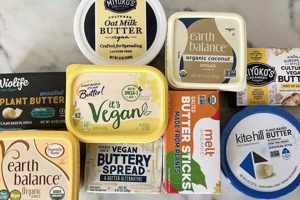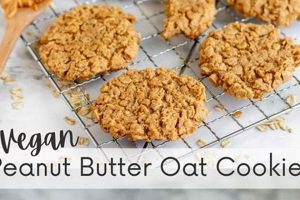A plant-based dish emulating the flavors of traditional butter chicken, this culinary creation substitutes dairy with vegan alternatives and chicken with tofu. The tofu is typically pan-fried or baked to achieve a desirable texture before being simmered in a creamy, tomato-based sauce infused with spices. Cashew cream or coconut milk are often used to replicate the richness of dairy butter and cream.
This innovation allows individuals adhering to vegan or dairy-free diets to enjoy a familiar and comforting dish. It offers a protein-rich alternative to traditional recipes and demonstrates the versatility of plant-based ingredients. Historically, the rise in popularity of this dish reflects a growing awareness of ethical and environmental concerns related to animal agriculture, coupled with an increased interest in plant-based cuisine.
The subsequent sections will delve into the specific methods for preparing this dish, exploring variations in ingredients and techniques, and examining the nutritional profile it provides. The aim is to provide a thorough understanding of the processes involved in crafting a delicious and satisfying meal.
Preparation Guidelines
The following guidelines aim to enhance the preparation and flavor profile of this particular dish, ensuring a satisfying culinary experience.
Tip 1: Tofu Pressing. Prior to cooking, press the tofu to remove excess water. This results in a firmer texture and allows for better absorption of the sauce’s flavors. Utilize a tofu press or a weighted object for approximately 30 minutes.
Tip 2: Tofu Cubing. Size consistency is important. Cut the tofu into uniform cubes to ensure even cooking and prevent some pieces from being overcooked while others remain undercooked.
Tip 3: Marinade Consideration. Marinate the tofu for at least 30 minutes before cooking. A mixture of soy sauce, ginger, and garlic can significantly enhance its flavor before adding it to the sauce.
Tip 4: Spice Tempering. Bloom the spices in oil before adding the remaining ingredients. This process releases their essential oils, intensifying the aroma and flavor of the sauce.
Tip 5: Sauce Consistency. Adjust the consistency of the sauce by adding vegetable broth or water, achieving the desired thickness and ensuring the tofu is adequately coated.
Tip 6: Vegan Butter Quality. Select a high-quality vegan butter alternative that melts smoothly and adds richness to the sauce. Some brands may impart a slightly different flavor profile, so experimentation is encouraged.
Tip 7: Garnishing Techniques. Garnish the finished dish with fresh cilantro or a sprinkle of red pepper flakes to enhance its visual appeal and add a final layer of flavor.
Adhering to these guidelines will contribute to a more flavorful and texturally pleasing dish, maximizing the enjoyment of this plant-based creation.
The concluding sections will provide insights into serving suggestions and potential side dishes, completing the overview of its preparation and presentation.
1. Plant-Based Protein
Plant-based protein is a foundational element of a dish that replicates the flavors of traditional butter chicken using entirely vegan ingredients. Tofu, derived from soybeans, serves as the primary protein source, replacing the chicken found in the original recipe. The use of tofu addresses the need for a significant protein component in a balanced meal, mirroring the nutritional profile of its non-vegan counterpart. For instance, a single serving of tofu can provide a substantial portion of the daily recommended protein intake. Without this plant-based protein component, the dish would lack a key structural element and nutritional value.
Beyond nutritional considerations, the type and preparation of the plant-based protein directly influence the final texture and flavor. Firm or extra-firm tofu is generally preferred, as it holds its shape well during cooking and provides a satisfying bite. Pressing the tofu before cooking further enhances its texture by removing excess water. The tofu absorbs marinades and sauces more effectively. Properly prepared, the tofu mimics the mouthfeel of chicken, contributing to the overall success of this vegan adaptation. Seitan, another plant-based protein, can serve as a viable alternative, offering a different texture and flavor profile.
The incorporation of plant-based protein into this vegan recipe enables individuals adhering to plant-based diets to enjoy a familiar and culturally significant dish. It also demonstrates the versatility of plant-derived ingredients in replicating traditional dishes, thereby promoting sustainable and ethical eating practices. Understanding the role and impact of plant-based protein is therefore critical to the successful preparation and appreciation of the dish.
2. Dairy-Free Alternative
The designation as a dairy-free alternative is fundamental to the concept and execution of this plant-based dish. Traditional butter chicken relies heavily on dairy, specifically butter and cream, to achieve its characteristic richness and creamy texture. The removal of these ingredients is a necessary condition for the dish to be considered vegan, thus serving individuals with lactose intolerance, dairy allergies, or those adhering to a vegan lifestyle. The absence of dairy necessitates the substitution of ingredients that can emulate its properties without compromising the dish’s overall flavor profile and textural appeal. Cashew cream, coconut milk, and specific vegan butter alternatives are commonly employed to achieve this emulation. Therefore, the dairy-free alternative component is not merely an optional addition; it is an integral requirement for the dishs identity.
The selection of appropriate dairy substitutes directly impacts the final outcome. For instance, coconut milk imparts a subtle sweetness and coconut flavor, while cashew cream provides a neutral, velvety texture. High-quality vegan butter alternatives are crucial for replicating the buttery richness that defines the traditional dish. Experimentation with different substitutes and combinations is often required to achieve the desired taste and consistency. Furthermore, the preparation methods are adjusted to compensate for the absence of dairy. This could involve techniques such as thickening the sauce with cornstarch or using a higher proportion of tomatoes to achieve a similar level of tanginess.
In summary, the dairy-free alternative is a defining characteristic of this vegan dish, influencing ingredient selection, preparation techniques, and the overall sensory experience. Understanding the specific properties of various dairy substitutes and their impact on the final product is essential for successfully recreating this classic dish in a vegan-friendly format. The challenges associated with replicating the unique qualities of dairy are addressed through careful experimentation and a nuanced understanding of plant-based ingredients, thereby ensuring a satisfying and authentic dairy-free experience.
3. Spice Infusion Methods
Spice infusion methods are critical to the success of vegan butter tofu, as they determine the depth and complexity of the dish’s flavor profile. The absence of dairy, which contributes a certain richness and mouthfeel in traditional butter chicken, necessitates a heightened focus on spice utilization to compensate and create a similarly satisfying sensory experience. Different methods unlock various facets of the spices’ aromatic compounds, influencing the final taste. For instance, tempering spices in hot oil releases their volatile oils, creating a more intense and nuanced flavor base compared to simply adding ground spices to the sauce. This initial step directly impacts the overall aroma and taste, establishing the foundation upon which the other flavors are built.
The timing and order of spice addition also play a significant role. Whole spices, such as cinnamon sticks or cardamom pods, often benefit from being added early in the cooking process to allow their flavors to slowly permeate the sauce. Ground spices, on the other hand, are typically added later to prevent them from burning and becoming bitter. A proper balance must be struck between the individual spices used. Common spices like garam masala, turmeric, cumin, and coriander each contribute distinct notes, and their proportions must be carefully considered to achieve a harmonious blend. Some chefs prefer to create their own garam masala blends, tailoring the spice profile to their specific preferences. The real-life consequence of improper spice infusion is a bland or unbalanced dish, failing to capture the essence of authentic butter chicken. Therefore, mastering these methods is essential for culinary efficacy.
In conclusion, spice infusion methods are not merely a procedural step; they represent a pivotal aspect of vegan butter tofu preparation, directly influencing the dish’s flavor, aroma, and overall palatability. While the absence of dairy presents a culinary challenge, a deep understanding of spice infusion techniques allows for the creation of a vibrant and satisfying vegan alternative. Future development in this area might involve exploring novel spice combinations or infusion techniques, further elevating the dish’s complexity.
4. Tofu Texture Variation
The textural quality of tofu within the vegan butter tofu dish is a crucial determinant of the overall culinary experience. Different tofu textures offer distinct advantages and disadvantages, impacting the dish’s perceived quality and satisfaction.
- Extra-Firm Tofu: Stability and Bite
Extra-firm tofu, due to its low water content, maintains its shape during cooking, preventing excessive crumbling within the sauce. This textural stability provides a more substantial bite, akin to the texture of chicken in traditional butter chicken. However, its inherent dryness necessitates careful saucing to ensure adequate moisture.
- Firm Tofu: Versatility and Absorption
Firm tofu strikes a balance between stability and moisture absorption. It retains its shape reasonably well while still absorbing flavors from the sauce. This makes it a versatile choice suitable for various cooking methods, including pan-frying, baking, or simmering directly in the sauce. It represents a middle ground, acceptable to a wider range of preferences.
- Silken Tofu: Creaminess and Sauce Enhancement (Use with Caution)
Silken tofu, with its high water content and delicate texture, is not typically employed as the primary tofu component. However, it can be pureed and incorporated into the sauce to enhance its creaminess, mimicking the richness of dairy. Direct use as the main tofu is generally avoided as it tends to disintegrate during cooking, negatively impacting the dish’s structural integrity. It may be used as a side dish ingredient however.
- Preparation Methods: Influencing Final Texture
Regardless of the initial tofu type, preparation methods significantly alter the final texture. Pressing tofu removes excess water, resulting in a firmer, chewier texture. Marinating enhances flavor absorption, further contributing to the overall palatability. Frying or baking before adding to the sauce creates a crisped exterior, adding textural contrast.
Ultimately, the selection and preparation of tofu for vegan butter tofu should align with desired textural outcomes. Experimentation with different types and techniques enables culinary personalization, improving the user-experience of this vegan adaptation. While the choice is subjective, understanding the impact of each texture allows for informed decision-making in the kitchen, yielding a more satisfying final dish.
5. Sauce Creaminess Source
The creamy texture of vegan butter tofu, a key characteristic mimicking traditional butter chicken, necessitates a strategic source for this mouthfeel. Given the absence of dairy, the choice of ingredients and techniques to achieve this creaminess is paramount to the dish’s success. The source of this texture significantly influences not only the mouthfeel, but also the flavor profile and nutritional content of the final product.
- Cashew Cream: Neutral Flavor and Rich Texture
Cashew cream, created by blending soaked cashews with water, offers a neutral flavor profile that allows the spices to remain prominent. Its naturally high fat content contributes a richness and smoothness closely resembling dairy cream. Soaking time and blending intensity are critical factors, with longer soak times and high-speed blending yielding the smoothest results. The success of cashew cream hinges on breaking down cashew particles to a microscopically small size. This helps provide a non-gritty consistency.
- Coconut Milk: Tropical Note and Cost-Effectiveness
Coconut milk, particularly full-fat varieties, provides a creamy texture with a subtly sweet, tropical flavor. The canned variety typically offers a higher fat content and therefore a richer texture compared to refrigerated coconut milk beverages. It’s more cost-effective than some other vegan cream alternatives. It may however impart a detectable coconut flavor, which could either enhance or detract from the overall flavor, depending on preference. The flavor is also dependent on the amount that is used. The presence of coconut is reduced the more it is blended with other ingredients.
- Vegan Butter Alternatives: Buttery Flavor and Emulsification
Vegan butter alternatives, often composed of plant-based oils, contribute a buttery flavor and enhance emulsification within the sauce. Selection of a high-quality brand is essential, as formulations vary widely. Some brands may contain ingredients that negatively impact flavor or texture. Incorporating vegan butter adds a layer of richness and depth, effectively replacing the traditional dairy butter used in butter chicken. Be cautious about flavor. The flavor of some plant-based butter alternatives is very strong, and will affect the overall taste of the dish. Use sparingly.
- Sunflower Seed Cream: A Neutral and Allergen-Free Option
Sunflower seed cream, made similarly to cashew cream, provides a neutral-flavored alternative for individuals with nut allergies. Soaked sunflower seeds, when blended with water, create a smooth, creamy base. Unlike cashews, sunflower seeds can sometimes impart a slightly bitter flavor. This can be mitigated by briefly boiling the seeds before soaking. This method is a good option for individuals with nut allergies as it has a neutral flavor that compliments the spices, but can also be bland.
The careful selection and preparation of the sauce’s creamy component fundamentally defines the vegan butter tofu experience. Each option presents unique advantages and disadvantages regarding flavor, texture, cost, and allergenicity. Culinary expertise lies in selecting the ingredient that best achieves the desired sensory profile while catering to specific dietary requirements or preferences. Future innovations might explore other sources to enhance creaminess, thus leading to a greater optimization of the dish.
6. Nutritional Considerations
Nutritional considerations are paramount when evaluating the suitability of vegan butter tofu as a dietary choice. Understanding the macronutrient profile, micronutrient content, and potential health implications is essential for informed consumption.
- Protein Source and Completeness
Tofu, the primary protein source, provides essential amino acids necessary for human health. However, the completeness of the protein varies based on processing and preparation. Combining tofu with other plant-based protein sources, such as brown rice, can ensure a more complete amino acid profile. Adequate protein intake supports muscle maintenance and overall physiological function.
- Fat Content and Type
The creaminess of vegan butter tofu often derives from cashew cream, coconut milk, or vegan butter alternatives, all of which contribute to the fat content. Saturated fats from coconut milk should be consumed in moderation, while unsaturated fats from cashews are generally considered more beneficial. Understanding the types and amounts of fats is crucial for managing cardiovascular health.
- Sodium Content and Source
Soy sauce, a common ingredient, contributes significantly to the sodium content. High sodium intake can elevate blood pressure and increase the risk of cardiovascular disease. Choosing low-sodium soy sauce or carefully monitoring portion sizes can mitigate this risk. Awareness of sodium sources is essential for maintaining healthy sodium levels.
- Micronutrient Profile and Bioavailability
Turmeric, often used for its anti-inflammatory properties, contains curcumin, a potent antioxidant. However, the bioavailability of curcumin is limited. Combining it with black pepper, which contains piperine, enhances absorption. Similarly, the iron content of tofu can be improved by consuming it with vitamin C-rich foods. Enhancing bioavailability increases the nutritional benefits.
The nutritional profile of vegan butter tofu can be optimized through mindful ingredient selection and preparation techniques. Balancing macronutrient ratios, monitoring sodium intake, and enhancing micronutrient bioavailability contribute to a healthier dietary option. Analyzing the composition promotes informed dietary decisions to meet specific health goals.
7. Culinary Adaptability
The inherent culinary adaptability of vegan butter tofu stems from its foundational flexibility in ingredient substitution and modification. While emulating the flavors of traditional butter chicken, it readily accepts variations in spices, vegetables, and thickening agents without compromising its core identity. This adaptability expands its potential reach across diverse dietary needs and culinary preferences, permitting the incorporation of locally available ingredients and regional flavor profiles. A direct consequence of this adaptability is the ease with which the dish can be customized to cater to allergies, specific dietary restrictions, or individual taste preferences. If cashew allergies are a concern, for instance, sunflower seeds or pumpkin seeds can replace cashews for a creamy texture without sacrificing the essence of the dish.
Consider the spices: While garam masala forms the base, the ratios and inclusion of individual spices can be adjusted to reflect regional spice palettes. In Southeast Asian interpretations, lemongrass or galangal might be integrated, while a Mediterranean take could incorporate smoked paprika or oregano. This demonstrates its utility in different culinary traditions. Similarly, the level of heat can be modified by adjusting the quantity of chili peppers or using different varieties. The adaptability also extends to incorporating various vegetables, such as bell peppers, spinach, or cauliflower, enhancing its nutritional content and textural complexity. Practical application is further seen in its integration with different grain bases. While often served with rice, it pairs equally well with quinoa, naan bread, or even pasta, expanding its utility in various cultural contexts.
In summary, the culinary adaptability of vegan butter tofu is not merely a superficial attribute but a fundamental aspect of its design. It facilitates the integration of diverse ingredients and flavor profiles, catering to a broad range of dietary needs and culinary preferences. This inherent flexibility ensures its enduring relevance and popularity in a constantly evolving culinary landscape. Challenges primarily involve maintaining the core flavor identity while accommodating significant alterations. Successfully balancing these considerations ensures the dish remains both recognizable and adaptable, solidifying its place as a versatile and inclusive culinary option.
Frequently Asked Questions
The following section addresses common queries regarding the preparation, ingredients, and nutritional aspects of vegan butter tofu.
Question 1: Is vegan butter tofu a healthy dietary option?
The healthfulness of vegan butter tofu depends on ingredient choices and preparation methods. Prioritizing whole, unprocessed ingredients, moderating sodium and saturated fat content, and ensuring a balanced macronutrient profile contributes to a nutritious meal.
Question 2: Can different types of tofu be used interchangeably in this dish?
While various tofu textures can be utilized, the final outcome is impacted. Extra-firm tofu maintains its shape best, while silken tofu is unsuitable as a direct replacement due to its fragility. Firm tofu is often considered an acceptable middle ground.
Question 3: How can the creaminess of the sauce be achieved without using cashews?
Alternatives such as coconut milk, sunflower seed cream, or white beans can effectively replicate the creamy texture. Sunflower seed cream is an excellent substitute for individuals with tree nut allergies.
Question 4: What spices are essential for achieving an authentic butter chicken flavor?
Garam masala, turmeric, cumin, coriander, and ginger are crucial for creating the characteristic spice blend. Adjusting their ratios can tailor the flavor profile to individual preferences.
Question 5: How can excess water be effectively removed from the tofu?
Pressing the tofu, either with a dedicated tofu press or by placing it between weighted plates, is recommended. This process improves the tofu’s texture and its ability to absorb flavors.
Question 6: Can vegan butter tofu be prepared in advance?
Yes, the dish can be prepared in advance and stored in the refrigerator for up to three days. The flavors often meld and deepen upon reheating. It is suitable for meal preparation.
In summary, the versatility of vegan butter tofu enables dietary customization. Mindful ingredient selection and preparation lead to a satisfying and nutritious plant-based meal.
The subsequent section delves into advanced techniques for enhancing the flavor and texture of this dish, offering insights for experienced cooks.
Conclusion
Vegan butter tofu presents a compelling adaptation of a classic dish, demanding careful consideration of ingredient selection and preparation techniques. Throughout this exploration, key elements such as plant-based protein sources, dairy-free alternatives, spice infusion methods, tofu texture variation, creamy sauce creation, and nutritional considerations have been thoroughly examined. Culinary adaptability has been underscored, emphasizing its capacity to integrate diverse ingredients and flavor profiles.
The continued development of vegan cuisine hinges on a commitment to both culinary innovation and nutritional awareness. Further research into plant-based alternatives and refined cooking methods is essential for optimizing the flavor, texture, and health benefits of dishes like vegan butter tofu. The successful implementation of these principles will ultimately contribute to a more sustainable and inclusive culinary landscape.







